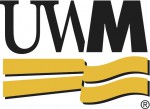NSF Invests in Cyberinfrastructure Institute to Harness Cosmic data
“Multi-messenger astrophysics is a data-intensive science in its infancy that is already transforming our understanding of the universe.”
MILWAUKEE _ The National Science Foundation awarded the University of Wisconsin-Milwaukee and nine other collaborating organizations $2.8 million to further develop the concept for a Scalable Cyberinfrastructure Institute for Multi-Messenger Astrophysics (SCIMMA).
Multi-messenger astrophysics combines observations of light, gravitational waves and particles to understand some of the most extreme events in the universe. For example, the observation of gravitational waves and light from the collision of two neutron stars in 2017 helped explain the origin of heavy elements, allowed an independent measurement of the expansion of the universe and confirmed the association between neutron-star mergers and gamma-ray bursts.
“Multi-messenger astrophysics is a data-intensive science in its infancy that is already transforming our understanding of the universe,” said Patrick Brady, UWM physics professor and director of the Leonard E. Parker Center for Gravitation, Cosmology and Astrophysics.
“The promise of multi-messenger astrophysics, however, can be realized only if sufficient cyberinfrastructure is available to rapidly handle, combine and analyze the very large-scale distributed data from all types of astronomical measurements. The conceptualization phase of SCIMMA will balance rapid prototyping, novel algorithm development and software sustainability to accelerate scientific discovery over the next decade and more.”
“SCIMMA is bringing data scientists, computer scientists, astronomers, astro-particle physicists and gravitational-wave physicists together to leverage NSF investments in large astronomical facilities and cyberinfrastructure,” said Amy Walton, program director, NSF Office of Advanced Cyberinfrastructure. These investments include the Laser Interferometer Gravitational-Wave Observatory (LIGO), IceCube Neutrino Observatory, Large Synoptic Survey Telescope (LSST), and multiple cosmic ray and neutrino observatories.
“SCIMMA is supported by two of NSF’s Big Ideas — Harnessing the Data Revolution and Windows on the Universe,” added Nigel Sharp, program director in the Division of Astronomical Sciences.
The SCIMMA project, entitled “A Framework for Data Intensive Discovery in Multi-Messenger Astrophysics,” is under the direction of Brady and co-principal investigators Chad Hanna (Penn State), Mario Juric (University of Washington) and David L. Kaplan (UWM).
“The SCIMMA project team is excited to play a part in making NSF’s ‘Big Ideas’ a reality,” said UWM Chancellor Mark Mone, “and is working diligently to bring scientists and cyberinfrastructure experts closer together to harness the data revolution and open windows on the universe.”
Project collaborators include Columbia University; Cornell University Center for Advanced Computing (CAC) and the Department of Astronomy; Las Cumbres Observatory; Michigan State University; Pennsylvania State University-University Park; University of California-Santa Barbara; National Center for Supercomputing Applications (NCSA), University of Illinois at Urbana-Champaign; Texas Advanced Computing Center (TACC) at The University of Texas at Austin; and the University of Washington.
The project’s two-year conceptualization phase began Sept.1, 2019. Besides enabling seamless co-analysis of disparate datasets by supporting the interoperability of software and data services, this phase will include the development of novel education and training curricula designed to enhance the STEM workforce.
For more information, visit https://scimma.org/.
About UWM
Recognized as one of the nation’s 131 top research universities, UW-Milwaukee provides a world-class education to 26,000 students from 91 countries on a budget of $689 million. Its 15 schools and colleges include Wisconsin’s only schools of architecture, freshwater sciences and public health, and it is a leading educator of nurses and teachers. UW-Milwaukee partners with leading companies to conduct joint research, offer student internships and serve as an economic engine for southeastern Wisconsin. The Princeton Review named UW-Milwaukee a 2020 “Best Midwestern” university based on overall academic excellence and student reviews.
NOTE: This press release was submitted to Urban Milwaukee and was not written by an Urban Milwaukee writer. While it is believed to be reliable, Urban Milwaukee does not guarantee its accuracy or completeness.






















